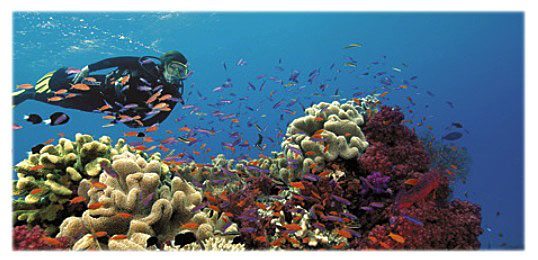As the plane begins the descent into Nadi (Nan-dee), Fiji, passengers eagerly press their faces closer to the windows. Glistening below is the multicolored turquoise water of the Pacific, a scene that is beautiful to behold from an aerial view, but for divers holds a special allure. Upon arriving, guests are met with a chorus of “bula, bula” (Fijian for hello) from a crowd of friendly, smiling Fijian faces. For many of these travelers, this will be the trip of a lifetime when they experience the gracious people, the romantic palm-studded beaches, and especially the world-class diving.
Volcanic Origins
Fiji, northeast of Australia and southwest of Hawaii, is made up of 330 islands, of which only about 100 are inhabited. The largest of the islands are Viti Levu (vee-tee lay-vu), which is home to the capital city of Suva, and to the north, Vanua Levu Island (van-ou-a lay-vu). Eighty percent of the population lives on these two islands, which make up 87 percent of Fiji’s landmass. The highest point is Tomanivi (toh-man-e-vee) at 4,369 feet (1,324 m), the tip of a long-extinct volcano. All the islands are the remains of volcanic activity. Most of the largest lagoons, such as Beqa (bang-guh) lagoon in the southern islands, are the remains of volcanoes that have long since collapsed.
Since there was no written language before the Europeans arrived, the early history of Fiji is sketchy. It is accepted that the first inhabitants were the Lapita, who came to the islands around 1500 B.C.; they were named for an area in New Caledonia from where it is believed they originated. The islands were visited and partially inhabited by the Tongans and Samoans, who left behind many of their traditions that are still practiced today.
The Fijians are some of the warmest and most gracious people in the world, but it has not always been that way. At one time, they were cannibals. One historical account states that when Captain Bligh was thrown off the Bounty, he made his way between Viti Levu and Vanua Levu, but he chose not to land because of the reputation of the fierce warriors who inhabited the islands. The practice of cannibalism began to change in the 1830s when Christian missionaries arrived, and by 1874 Fiji became a British crown colony. In 1970 Fiji gained independence from British rule.
Elections in 1987 created a coalition of mainly Indian descendants, and this arrangement was a major source of unrest for the native Fijians. In the early 1990s, a coup headed by a Fijian military officer of Melanesian descent set the stage for free elections held in 1992. Fiji now has one of the only governments in the world primarily run by its endemic people in which the “Greater Council of High Chiefs” remains very influential in the politics of the country.
The Fijian economy is one of the most developed economies throughout the islands of the South Pacific. About one-third of all national industry consists of sugar cane processing. It is not unusual to see high stacks of sugar cane being transported to the processing plants on small-rail trains. Other exports include gold, clothing, timber and processed fish, and one of the fastest-growing sectors of the economy involves the growing popularity of tourism.
Fijian Traditions
Perhaps one of the most time-honored traditions is the kava ceremony. Kava comes from the roots of a plant in the pepper family. Dried roots are pounded into a powdered form and mixed with water.
Participants in the kava ceremony sit in a circle on the floor with their Fijian hosts. A small bowl is filled with kava from the larger ceremonial bowl and is then passed to the first guest by the cup bearer. The bowl is refilled for each participant when it is his or her turn to drink. There is an established ritual around the kava ceremony that includes clapping of the hands three times after emptying the bowl and making a “yucky face” to indicate how yummy the concoction tastes. Even though it looks like muddy water and has a bitter taste, kava is said to have a calming effect.
Travelers can also share in the tradition of storytelling. To preserve their heritage, each generation passes their history to the next generation through the art of storytelling, known as the Talanoa (tal-uh-no-uh), and the stories were often shared during the traditional kava ceremony. Another popular form of storytelling is known as Meke (meck-ee), which includes dances created by the Fijian natives that were also used to carry their history down through the ages. The Meke, frequently used to entertain visitors to the islands, is performed in native costumes and provides a most enjoyable show.

1 comment:
nice one Stuart!!
Post a Comment